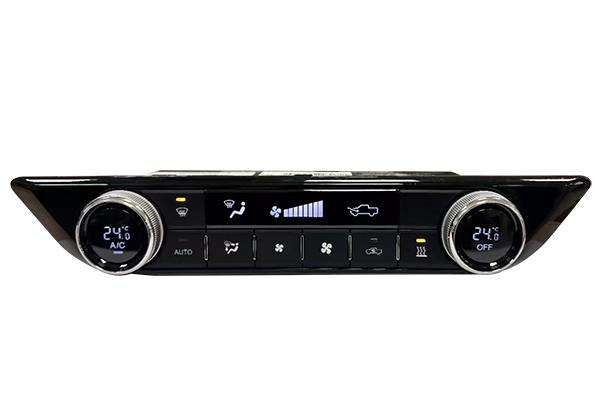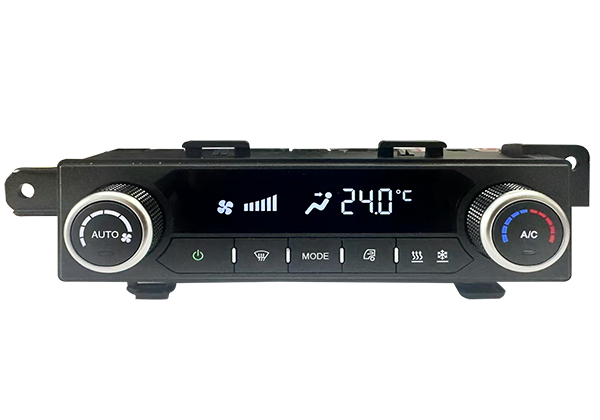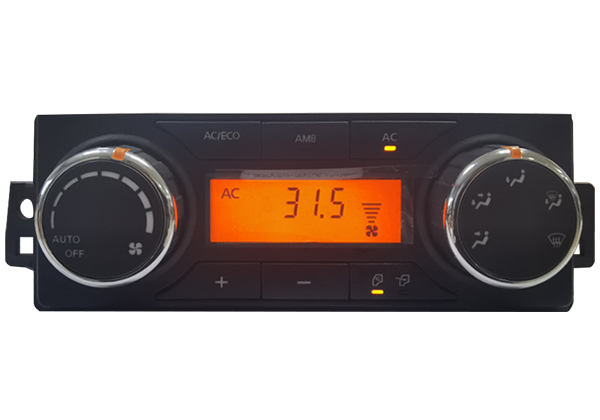
2025-08-13
The car air conditioning controller is an essential component to adjust the driving environment. From the previous simple manual air conditioning to the current automatic air conditioning, LCD as an essential human-computer interaction medium, makes the human-computer interaction more simple and friendly.
In the early 2000s, with the significant reduction of hardware and development costs, TFT color liquid crystal displays were rapidly popularized in the automotive instrumentation industry. With the rise of central control entertainment and navigation in automobiles, automotive air conditioning controllers were gradually integrated into the central control system.
However, due to the increasingly complex control and operation interfaces of automotive air conditioning systems integrated into central control units, coupled with growing consumer complaints, this solution has gradually been abandoned by OEMs.The LCD segment display air conditioning controller solution has regained prominence in the developer community, particularly with the widespread adoption of rear-seat cabin air conditioning controllers. Recognized for its cost-effective LCD technology and short development cycles, this display solution has become a preferred choice for automotive manufacturers.

1、Market size and growth drivers
1. Overall market space
The global automotive air conditioning controller market is expected to reach $4.9 billion in 2032, with a compound annual growth rate of 5.0%, among which the penetration rate of digital control panels continues to increase.
As the core of growth, China’s production capacity of LCD display control panels for automotive air conditioning will exceed 20 million sets by 2030, accounting for 40% of the global total. The demand is mainly from new energy vehicles (penetration rate over 30%) and intelligent cockpit upgrades.
2. Subdivisional requirements of LCD segment display
LCD segment display occupies 35%-40% share in low cost models and basic function controllers, mainly due to its cost advantage (unit price less than 1/3 of color TFT-LCD) and Low power LCD (standby power consumption is only 0.5μA).
Application scenarios focus on manual/semi-automatic air conditioning controllers (accounting for 70% of low-end models), industrial vehicle dashboard and aftermarket replacement parts.
II. Demand drivers
1. Cost and reliability requirements
The BOM cost of LCD segment display is more than 50% lower than that of full color screen, and the built-in charge pump ensures display stability in voltage fluctuations, suitable for 12V vehicle power supply environment.
Industrial-grade wide temperature LCD support (-30℃ to 85℃) and shock-resistant design (IP65 protection) meet automotive grade reliability standards (such as AEC-Q100).
2. Incremental demand for new energy vehicles
Electric vehicles need to independently control the battery cabin and passenger cabin air conditioning, drive the multi-region temperature control system popularization, LCD segment display because of low power consumption (<100nA) become the first choice of auxiliary control panel.
In 2024, LCD segment display penetration rate in air conditioning secondary control panel will reach 65% for electric models.
3. Policy and standardization drive
The mandatory energy efficiency labeling of new energy vehicles in the European Union and China shows that monochrome screens have become the core components of energy efficiency indicator modules for instruments due to their long life (> 100,000 hours).
III. Technology Trends and Innovation
1. Integrated driving solution
MCU+LCD driver integration: such as Lingdong Microelectronics MM32L0130 series, which integrates charge pump and bit code driver, supports 40×4 bit code layout, reduces peripheral components by 30%, and is suitable for air conditioning remote control and car temperature controller.
Multi-protocol communication interface: supports LIN/CAN bus transmission of temperature data, to achieve seamless interaction with the vehicle network.
2. Function upgrade direction
Dynamic display enhancement: ROHM drivers support adjustable flicker frequency (0.5-4Hz) for fault alarms or mode switching prompts.
Flexible display exploration: The bendable segment code screen is in trial production in the curved air conditioning panel, but the mass production cost is still a bottleneck.
IV. Major manufacturers and technical routes
International giants: ROHM leads the high reliability automotive-grade drivers (such as BD series), which support 66×8 bit code and 105℃ high temperature operation, occupying 50% of the high-end market share.
Chinese supplier: Lingdong Microelectronics entered the aftermarket market through MM32L0130, focusing on the “MCU+ driver” integrated solution, reducing the cost by 25%.
V. Challenges and substitution risks
1. Pressure of technological substitution
The price of full-color TFT-LCD drops by 8% annually, and it gradually penetrates into the models below 100,000, squeezing the space of monochrome screen in the middle market.
Electronic paper (E-paper) is emerging in the field of smart labels, and its standby power consumption characteristics may divert the demand for meters.
2. Inadequate supply chain resilience
The dependence on imported drives exceeds 90%, and the risk of supply interruption may be caused by geopolitical conflicts (such as the recurrence of the Ukrainian wiring crisis).

Summary and outlook
Short-term opportunities (2025-2027):
Seize the upgrade window of new energy vehicle secondary control panels (such as rear temperature control, battery status display) and basic air conditioning system of commercial vehicles, and focus on the layout of integrated drive solutions.
Long-term Strategy (2028-2030):
Extend to high value-added scenarios: industrial control instruments (oil resistant/anti-vibration), medical vehicle equipment (EMC compatible), and develop curved embedded panels combined with flexible technology.
LCD segment displays remain the golden balance point of “cost-performance + reliability” in the automotive air conditioning controller field, but they need to cope with the dual challenges of TFT screen downward trend and supply chain localization. Enterprises should strengthen the integrated design capability with MCU manufacturers, and explore e-paper hybrid display solutions to extend the technology life cycle.
As a leading LCD manufacturer in mainland China, Eastern Display has been dedicated to the development, design, and production of automotive LCDs since the 1990s. Since the early 21st century, the company has provided high-quality LCD products, particularly VALCD series, to automotive air conditioning controller manufacturers. These solutions meet the stringent requirements for wide temperature tolerance, high contrast ratio, and broad viewing angles in automotive air conditioning displays. Currently supplying over 10 million units to domestic and international clients including FAW, Dongfeng, Yutong, Leapmotor, Li Auto, Kia, Sany Heavy Industry, and Zoomlion, Eastern Display has earned widespread recognition and established a strong reputation in the automotive air conditioning industry.
